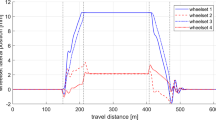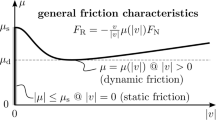Abstract
The parabolic leaf spring is widely used in modern vehicle suspension systems because it has many desirable features, such as weak interleaf friction and light weight. In this paper, the parabolic leaf spring is analyzed using automatic geometric data acquisition and the finite element (FE) absolute nodal coordinate formulation (ANCF). In order to account for manufacturing considerations in developing the virtual models, the relaxed uniform cubic B-spline is used to represent the leaf spring profile curves and geometry. Three-dimensional scanning techniques based on structured light and multiple images are explored in this study to automatically extract the leaf spring complex geometric data. A new procedure is proposed to develop the ANCF/FE mesh from the physical object. Both double-leaf uniform-thickness and double-leaf parabolic spring models are developed and analyzed using different ANCF elements. Using ANCF geometry, piecewise linearly tapered parabolic leaf spring models are constructed, accounting for the leaf pre-stress. The interleaf contact is enforced using a penalty approach and a smoothed Coulomb friction model. It is shown that the fully parameterized low-order beam and plate elements suffer from locking problems, while the thin plate element can lead to less accurate results. The use of the new strain split method (SSM) as a locking alleviation technique is also examined in this investigation. It is shown that while the current SSM implementation can be effective in solving the locking problem in the case of symmetric bending-dominant loading, it may not produce accurate results in the case of torsional loading. The comparative study performed demonstrates that the higher-order ANCF beam element is more suitable for developing the leaf spring models compared to other ANCF elements considered in this investigation. The numerical results obtained show that the friction effect in parabolic leaf springs is much weaker than that in the leaf spring with uniform-thickness.



























Similar content being viewed by others
References
Nunney, M.J.: Light and Heavy Vehicle Technology, 4th edn. Butterworth-Heinemann, Oxford (2007)
Suveg, I., Vosselman, G.: Reconstruction of 3D building models from aerial images and maps. ISPRS J. Photogramm. Remote Sens. 58, 202–224 (2004)
Li, Q., Yao, M., Yao, X., Xu, B.: A real-time 3D scanning system for pavement distortion inspection. Meas. Sci. Technol. 21, 015702-1-8 (2009)
Yao, A.W.L.: Applications of 3D scanning and reverse engineering techniques for quality control of quick response products. Int. J. Adv. Manuf. Technol. 26, 1284–1288 (2005)
Varady, T., Martin, R.R., Cox, J.: Reverse engineering of geometric models—an introduction. Comput. Aided Des. 29, 255–268 (1997)
Fancher, P.S., Ervin, R.D., MacAdam, C.C., Winkler, C.B.: Measurement and representation of the mechanical properties of truck leaf springs (No. 800905). SAE Technical Paper (1980)
Yum, Y.J.: Frictional behavior of automotive leaf spring. In: Science and Technology, 2000. KORUS 2000. Proceedings. The 4th Korea-Russia International Symposium, vol. 3, pp. 5–10 (2000)
Timoshenko, S.: Strength of Materials: Elementary Theory and Problems, 3rd edn. Van Nostrand-Reinhold, Princeton (1958)
Society of Automotive Engineers: Spring Design Manual, Warrendale, PA, SAE Paper No. J1123 (1990)
Guo, K.: Development of leaf spring kinematical model and its applications in improvement of truck braking and steering analysis (No. 912566). SAE Technical Paper (1991)
Zahavi, E.: Analysis of a contact problem in leaf springs. Mech. Res. Commun. 19, 21–27 (1992)
Shokrieh, M.M., Rezaei, D.: Analysis and optimization of a composite leaf spring. Compos. Struct. 60, 317–325 (2003)
Duan, L., Song, C., Yang, S., Fan, S., Lu, B.: High-precision modeling and simulation of the taper leaf spring of tandem suspension of commercial vehicles. J. Mech. Sci. Technol. 30, 3061–3067 (2016)
Yadav, N., Dewangan, R., Patnaik, M.: Minimization of stress in a parabolic leaf spring by local algorithm for constant & priorities. Int. J. Eng. Res. Appl. 2, 1897–1899 (2012)
Patnaik, M., Yadav, N., Dewangan, R.: Study of a parabolic leaf spring by finite element method & design of experiments. Int. J. Mod. Eng. Res. 2, 1920–1922 (2012)
Kumar, K., Aggarwal, M.: Finite element analysis and optimization of a mono parabolic leaf spring using CAE software. Eng. Solid Mech. 3, 85–92 (2015)
Kumar, K., Aggarwal, M.L.: Computer-aided FEA simulation of EN45A parabolic leaf spring. Int. J. Ind. Eng. Comput. 4, 297–304 (2013)
Omar, M.A., Shabana, A.A., Mikkola, A., Loh, W.Y., Basch, R.: Multibody system modeling of leaf springs. J. Vib. Control 10, 1601–1638 (2004)
Sugiyama, H., Shabana, A.A., Omar, M.A., Loh, W.Y.: Development of nonlinear elastic leaf spring model for multibody vehicle systems. Comput. Methods Appl. Mech. Eng. 195, 6925–6941 (2006)
Shabana, A.A.: Dynamics of Multibody Systems, 4th edn. Cambridge University Press, Cambridge (2013)
Yu, Z., Liu, Y., Tinsley, B., Shabana, A.A.: Integration of geometry and analysis for vehicle system applications: continuum-based leaf spring and tire assembly. J. Comput. Nonlinear Dyn. 11, 031011-1-11 (2016)
Patel, M., Shabana, A.A.: Locking alleviation in fully-parameterized ANCF beam elements: the strain split method. Technical Report # MBS2017-2-UIC, University of Illinois at Chicago (2017)
Yakoub, R.Y., Shabana, A.A.: Three dimensional absolute nodal coordinate formulation for beam elements: implementation and applications. Trans. Am. Soc. Mech. Eng. J. Mech. Des. 123, 614–621 (2001)
Shen, Z., Li, P., Liu, C., Hu, G.: A finite element beam model including cross-section distortion in the absolute nodal coordinate formulation. Nonlinear Dyn. 77, 1019–1033 (2014)
Orzechowski, G., Shabana, A.A.: Analysis of warping deformation modes using higher order ANCF beam element. J. Sound Vib. 363, 428–445 (2016)
Mikkola, A.M., Shabana, A.A.: A non-incremental finite element procedure for the analysis of large deformation of plates and shells in mechanical system applications. Multibody Syst. Dyn. 9, 283–309 (2003)
Dufva, K., Shabana, A.A.: Analysis of thin plate structures using the absolute nodal coordinate formulation. Proc. Inst. Mech. Eng. Part K J. Multi-body Dyn. 219, 345–355 (2005)
Fu, Y., Wan, Y., Wan, M., Wang, W.: Three-dimensional profile measurement of the blade based on surface structured light. Opt. Int. J. Light Electron Opt. 124, 3225–3229 (2013)
Rusu, R.: Semantic 3D object maps for everyday manipulation in human living environments. Ph.D. Dissertation, Institut für Informatik, Technische Universität München, Germany (2009)
Barone, S., Paoli, A., Razionale, A.V.: Three-dimensional point cloud alignment detecting fiducial markers by structured light stereo imaging. Mach. Vis. Appl. 23, 217–229 (2012)
Park, S., Baek, J., Moon, J.: Hand-held 3D scanning based on coarse and fine registration of multiple range images. Mach. Vis. Appl. 22, 563–579 (2011)
Quan, L.: Image-Based Modeling. Springer, New York (2010)
Salomon, D.: Computer Graphics and Geometric Modeling. Springer, London (2012)
Sopanen, J.T., Mikkola, A.M.: Description of elastic forces in absolute nodal coordinate formulation. Nonlinear Dyn. 34, 53–74 (2003)
Shabana, A.A.: Computational Continuum Mechanics, 3rd edn. Wiley, Chichester (2018)
Shabana, A.A.: ANCF reference node for multibody system analysis. Proc. Inst. Mech. Eng. Part K J. Multi-body Dyn. 229, 109–112 (2015)
Wang, Q., Tian, Q., Hu, H.: Dynamic simulation of frictional contacts of thin beams during large overall motions via absolute nodal coordinate formulation. Nonlinear Dyn. 77, 1411–1425 (2014)
Patel, M., Orzechowski, G., Tian, Q., Shabana, A.A.: A new multibody system approach for tire modeling using ANCF finite elements. Proc. Inst. Mech. Eng. Part K J. Multi-body Dyn. 230, 69–84 (2016)
Nachbagauer, K., Gruber, P., Gerstmayr, J.: A 3D shear deformable finite element based on the absolute nodal coordinate formulation. In: Multibody Dynamics, pp. 77–96. Springer, Dordrecht (2013)
Gerstmayr, J., Shabana, A.A.: Analysis of thin beams and cables using the absolute nodal co-ordinate formulation. Nonlinear Dyn. 45, 109–130 (2006)
Matikainen, M.K., Valkeapää, A.I., Mikkola, A.M., Schwab, A.L.: A study of moderately thick quadrilateral plate elements based on the absolute nodal coordinate formulation. Multibody Syst. Dyn. 31, 309–338 (2014)
New York City Department of Transportation, Street Design Manual (2015). http://www.nyc.gov/html/dot/downloads/pdf/nycdot-streetdesignmanual-interior-lores.pdf. Accessed 28 July 2017
Illinois Department of Transportation, Special Design Elements (2006). http://www.idot.illinois.gov/assets/uploads/files/doing-business/manuals-split/design-and-environment/bde-manual/chapter%2058%20special%20design%20elements.pdf. Accessed 28 July 2017
Mastinu, G., Manfred, P.: Road and Off-Road Vehicle System Dynamics Handbook. CRC Press, Boca Raton (2014)
Kat, C.J.: Validated leaf spring suspension models. Dissertation, University of Pretoria (2012)
Skrinjar, L., Slavič, J., Boltežar, M.: Absolute nodalcoordinate formulation in a pre-stressed large-displacementsdynamical system. Stroj. Vestn. J Mech. Eng. 63, 417–425 (2017)
Author information
Authors and Affiliations
Corresponding author
Ethics declarations
Conflict of interest
The authors declare that they have no conflict of interest.
Rights and permissions
About this article
Cite this article
Wang, T., Tinsley, B., Patel, M.D. et al. Nonlinear dynamic analysis of parabolic leaf springs using ANCF geometry and data acquisition. Nonlinear Dyn 93, 2487–2515 (2018). https://doi.org/10.1007/s11071-018-4338-3
Received:
Accepted:
Published:
Issue Date:
DOI: https://doi.org/10.1007/s11071-018-4338-3




